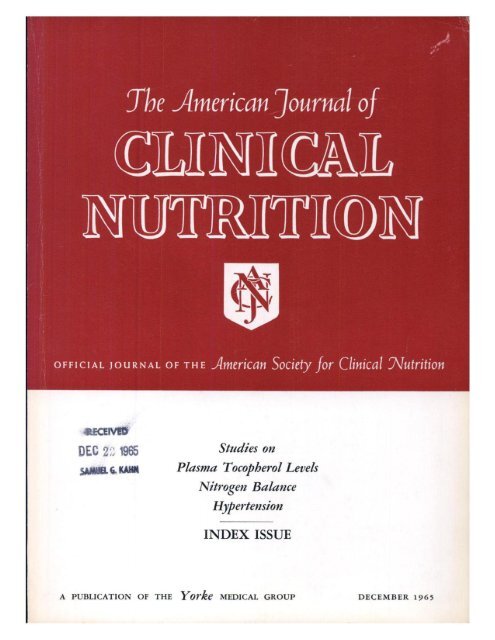EDIA 婴儿纵向队列中膳食纤维与肠道微生物组组成之间的关系。
IF 6.5
1区 医学
Q1 NUTRITION & DIETETICS
引用次数: 0
摘要
背景:婴儿肠道微生物群在出生后的第一年会发生快速变化,从而支持正常发育和长期健康。虽然饮食影响着这一过程,但人们对辅食中的纤维对肠道微生物组成熟的作用却知之甚少:我们探讨了从母乳到辅食中纤维的过渡如何影响出生后第一年内肠道微生物组的分类和功能成熟:我们使用线性混合模型评估了婴儿肠道微生物组(68 名婴儿)和代谢组(33 名婴儿)的纵向和横向发展情况,以揭示它们与膳食纤维及其食物来源之间的关联。根据符合 CODEX 标准的纤维成分值,通过 3 天的食物记录(3、6、9、12 个月)对纤维摄入量进行评估,并通过问卷调查跟踪辅食添加的总体情况。通过元基因组数据中的 MetaPhlAn2 对细菌种类进行了鉴定和量化,并使用四种 LC-MS 方法获得了代谢组图谱:结果:我们确定了 176 种辅助食品纤维与细菌物种的关联。首先,植物性纤维与母乳喂养的微生物群组成相似,并进一步与芳香族氨基酸代谢物(包括 5-羟基吲哚乙酸)相关(膳食纤维总量 - 辅助食品(克) - β=3.50, CI 2.48-4.52, p=6.53x10-5)。不同食物类别中的不同纤维与特定细菌类群有独特的联系。燕麦纤维(克/兆焦耳,β=2.18,CI 1.36-2.84,p=6.12x10-6)与粪便杆菌(Faecalibacterium prausnitznii)等关键物种相关,反映了微生物群落的成熟。断奶期间纤维的摄入与代谢物谱的变化有关,包括免疫调节代谢物,纤维的影响以来源和时间依赖的方式观察到,这与微生物群逐渐多样化有关:结论:在断奶期引入补充性膳食纤维有助于肠道微生物组的多样化和稳定。从断奶开始,即使是微小的膳食变化也显示出与微生物类群和功能的显著关联,这凸显了在生命早期支持肠道微生物组成熟的婴儿膳食建议的重要性:临床试验注册号:Clinicaltrials.gov Identifier:NCT01735123。注册日期:2012 年 11 月 24 日:https://www.Clinicaltrials:gov/ct2/show/NCT01735123。本文章由计算机程序翻译,如有差异,请以英文原文为准。
Associations between dietary fibers and gut microbiome composition in the EDIA longitudinal infant cohort
Background
The infant gut microbiome undergoes rapid changes in the first year of life, supporting normal development and long-term health. Although diet shapes this process, the role of fibers in complementary foods on gut microbiome maturation is poorly understood.
Objectives
We explored how the transition from human milk to fibers in complementary foods shapes the taxonomic and functional maturation of the gut microbiome within the first year of life.
Methods
We assessed the longitudinal and cross-sectional development of infant gut microbiomes (N = 68 infants) and metabolomes (N = 33 infants) using linear mixed models to uncover their associations to dietary fibers and their food sources. Fiber intakes were assessed with 3-d food records (months 3, 6, 9, and 12) relying on CODEX-compliant fiber fraction values, and questionnaires tracked the overall complementary food introduction. Bacterial species were identified and quantified via MetaPhlAn2 from metagenomic data, and metabolomic profiles were obtained using 4 LC-MS methods.
Results
We identified 176 complementary food fiber-bacterial species associations. First plant-based fibers associated with microbiota compositions similar to breastfeeding, and further associated with aromatic amino acid-derived metabolites, including 5-hydroxyindoleacetic acid (total dietary fiber – complementary foods (g) – β = 3.50, CI: 2.48, 4.52, P = 6.53 × 10–5). Distinct fibers from different food categories showed unique associations with specific bacterial taxa. Key species, such as Faecalibacterium prausnitznii, associated with oat fibers (g/MJ, β = 2.18, confidence interval: 1.36, 2.84, P = 6.12 × 10–6), reflective of maturing microbial communities. Fiber intake during weaning associated with shifts in metabolite profiles, including immunomodulatory metabolites, with fiber effects observed in a source- and timing-dependent manner, implicated in gradual microbiome diversification.
Conclusions
Introducing complementary dietary fibers during the weaning period supports gut microbiome diversification and stabilization. Even minor dietary variations shows significant associations with microbial taxa and functions from the onset of weaning, highlighting the importance of infant dietary recommendations that support the gut microbiome maturation during early life.
This trial was registered at clinicaltrials.gov as registration number NCT01735123.
求助全文
通过发布文献求助,成功后即可免费获取论文全文。
去求助
来源期刊
CiteScore
12.40
自引率
4.20%
发文量
332
审稿时长
38 days
期刊介绍:
American Journal of Clinical Nutrition is recognized as the most highly rated peer-reviewed, primary research journal in nutrition and dietetics.It focuses on publishing the latest research on various topics in nutrition, including but not limited to obesity, vitamins and minerals, nutrition and disease, and energy metabolism.
Purpose:
The purpose of AJCN is to:
Publish original research studies relevant to human and clinical nutrition.
Consider well-controlled clinical studies describing scientific mechanisms, efficacy, and safety of dietary interventions in the context of disease prevention or health benefits.
Encourage public health and epidemiologic studies relevant to human nutrition.
Promote innovative investigations of nutritional questions employing epigenetic, genomic, proteomic, and metabolomic approaches.
Include solicited editorials, book reviews, solicited or unsolicited review articles, invited controversy position papers, and letters to the Editor related to prior AJCN articles.
Peer Review Process:
All submitted material with scientific content undergoes peer review by the Editors or their designees before acceptance for publication.

 求助内容:
求助内容: 应助结果提醒方式:
应助结果提醒方式:


